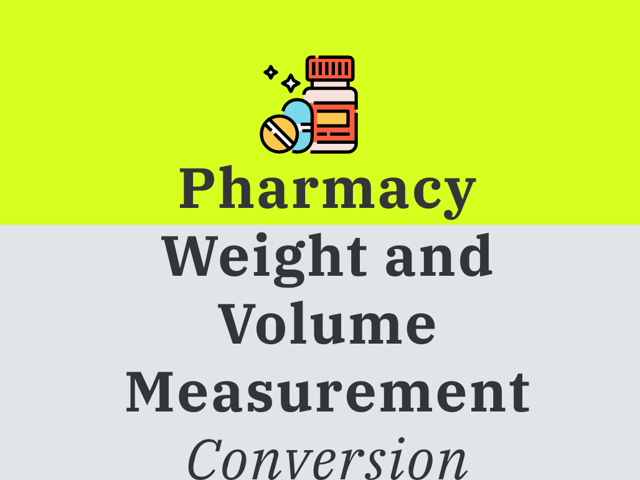
Pharmacy Weight and Volume Measurement Conversions
Being able to accurately calculate and measure weight, length, and volume is an essential skill to have in pharmacy practice. Pharmacy technicians should be confident in doing these calculations and also be comfortable with common measuring unit conversions. Remembering these simple pharmacy pearls will make calculating doses, days supply, and quantities that much easier. Regardless of which pharmacy setting you will be working in, conversions will be used on a daily basis.
An Example of the Conversion Process
Consider a scenario in which a prescriber writes the following prescription:
Latanoprost 0.005% eye drop - 1 drop into each eye nightly
Dispense: 2.5mL
3 Refills
As the technician, you input the prescription for processing and must provide the actual days supply for accuracy and insurance reimbursement purposes. If you think about it, 2.5mL of an eye drop does not seem like a large volume. Without knowing the correct conversion, how would one know how long one bottle would last the patient? Guessing is never the answer in pharmacy practice. Simply remembering that 1mL is equivalent to approximately 20 drops will lead you to the correct answer.
20 drops x 2.5mL = 50 drops total in the bottle of Latanoprost
50 drops/2 total drops in one day = 25 days
Conversions You Need to Know
This chart lists the most common conversions used in pharmacy practice. These should be committed to memory so that you can perform your job efficiently and accurately.
| Volume | Weight | Length |
|---|---|---|
| 1 tsp = 5 mL | 1 kg = 2.2 lb | 1 in = 2.54 cm |
| 1 tbsp = 15 mL | 1 gm = 10 dg = 100 cg = 1000 mg = 1 000 000 mcg |
1 m = 10 dm = 100 cm = 1000 mm = 1 000 000 mcm |
| 1 L = 10 dL = 1000 mL = 1 000 000 mcL |
1 grain = 64.8 mg | |
| 1 mL = \(\sim\) 20 drops | 1 lb = 16 oz | |
| 1 gal = 4 qt | 1 lb = \(\sim\) 454 gm | |
| 1 fl oz = 29.6 mL | ||
| 1 qt = 2 pt | ||
| 1 pt = \(\sim\) 473 mL |
Why Is This Important for a Pharmacy Technician?
Although the pharmacist does the ultimate check on every prescription and medication order, it is imperative that both pharmacist and technician are fluent in the information mentioned above. For a pharmacy to operate smoothly, the pharmacist relies on the technician to perform calculations with few or no errors. If the pharmacist has to fix incorrect dosing or days supply on multiple prescriptions, it will not only back up workflow but it also has the potential to cause patient harm if not caught prior to dispensing.
Do your due diligence in familiarizing yourself with these common conversions. Not only will you be happy, but the pharmacist you work with and patients you serve will be too. And always remember, guessing is never the answer. For more pharmacy calculation help and practice, check out our practice tests, study guides, and flashcards for the PTCB exam.
Keep Reading

PTCB Pharmacy Technician Certification Exam Blog
Memorable Mnemonics: Master Drug Knowledge for the PTCB Exam
Studying for the Pharmacy Technician Certification Board (PTCB) exam is…

PTCB Pharmacy Technician Certification Exam Blog
The Top 200 Drugs on the PTCB
The Pharmacy Technician Certification Board (PTCB) exam is the final st…

PTCB Pharmacy Technician Certification Exam Blog
Is the PTCB Exam Hard?
Is the PTCB Exam Hard? Did you know that in 2021, over 430,000 pharmac…